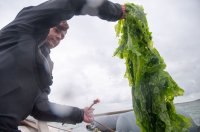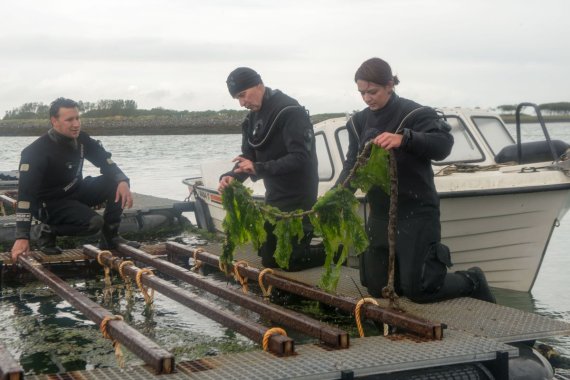Large bunches of green and brown seaweed surface when researcher Julia Wald pulls in a few ropes from the pontoon. It is chilly and raining on the Oosterschelde today and you have to watch your step on the slippery platform. Apparently the bright green sea lettuce has grown fast over the last few weeks so it will be harvested today. Wald simply snips off the seaweed with a kitchen scissors. It is taken off in a garbage bag, in this case to the laboratory.
This sea lettuce grows on the Wierderij, a Wageningen UR test site where researchers are experimenting with sustainable seaweed cultivation. An idea brought in by Willem Brandenburg, DLO researcher at Plant Research International (PRI), who sees it as a first step towards a new kind of crop farming. At sea.
Willem Brandenburg looks out over the Oosterschelde from ‘his’ marine farm.
Brandenburg has a vision for 2050. What he envisages is people growing enormous quantities of seaweed out at sea, sustainably as well as intensively. To this end, developments which on land took 10,000 years must be compressed into a couple of decades. ‘At sea we are still hunter-gatherers,’ says Brandenburg. ‘We hunt fish and dump our waste in the oceans.’ He has a vision of people as farmers at sea. Minerals for ‘green chemistry’ can be extracted from seaweed, as well as the proteins which the world population – 9 billion by 2050 – is crying out for. ‘But with just 2 percent of the total ocean surface – twice the size of Portugal,’ says Brandenburg, ‘we can meet the global need for protein.’ And these marine farms can be combined with aquaculture and wind farms, for example.
Cultivating seaweed can help reduce the negative impact of a growing world population. It would diminish the growing demand for farmland, for instance. Brandenburg hopes this would mean less destruction of nature. That way biodiversity would be preserved and biomass would not be turned into the greenhouse gas CO2. The seaweed can also absorb nutrients such as phosphate and nitrate. You can grow sea lettuce, for instance, in estuaries where the water can contain high concentrations of fertilizer ingredients. ‘Capturing’ these ingredients in seaweed is a first step towards a closed cycle.
Anyone standing on the Wierderij on a grey day can see that there is a lot to be done before Brandenburg’s vision becomes a reality. This is only a small test site. Four pontoons float alongside a central platform for the researchers, with ropes of seaweed hanging from them. In total the researchers are growing just a few dozen square metres of seaweed. It is not growing out at sea here but in a sheltered inlet created during the flood of 1953. A farm out at sea is exposed to the elements and is a lot less peaceful. The impact of this still needs to be studied. The water here is very clean and rich in nutrients, too. And yet there have already been some concrete results at the Wierderij since the project started in July 2011. The researchers now know, for instance, that you can grow seaweed in the Netherlands all year round. In the summer you can grow sea lettuce, a weed with a long green thallus, a leaf-like organ that feels like plastic.

Julia Wald inspects the sea lettuce, which grows fast in the summer.
In the winter the researchers grow brown seaweed species such as oarweed, which thrive in cold conditions. Per hectare the marine farm produces about 25 tonnes of ‘dry’ biomass. Brandenburg: ‘This makes the yield comparable with that of crop farming on land.’ Somewhat deeper under water the scientists would like to grow red seaweeds. There have been no results with this yet, but today a researcher from Zeeland applied sciences university is hanging ropes carrying a red kelp called lightfoot. The researchers came across some unexpected problems and teething troubles here too. The current state of the pontoons shows, for instance, how much the equipment suffers from the salt water, wind and waves. The metal parts have rusted away after four years and even the stainless steel is stained brown. One of the supports from which the ropes are hung even gave way under a researcher. And at the beginning of 2015 one of the ropes broke after having weathered all the storms until then without a problem. Brandenburg had estimated in advance that the ropes would last about 10 years. He is not so optimistic now. ‘Five years is probably more like it.’
It is also surprising how many uninvited guests turn up at the Wierderij. There are sea squids and other creatures on the ropes and around the pontoons. There are also other weeds such as wakame and Japanese wireweed: species the researchers do not want and are not even allowed to grow because they are invasive and are not indigenous to the Netherlands.
Researcher Willem de Visser, who swims happily in the surprisingly warm water, shows that you have to weed a marine farm too. Between the floats of the pontoon, algae grow which steal the seaweed’s light. De Visser patiently scoops them out by hand.
New market for Dutch seaweed
In recent years researchers at the LEI have been thinking about how a market for Dutch seaweed could be created. Worldwide there is already considerable demand for seaweed, mainly from Korea, Japan and China. ‘That seaweed is cheaper and it will probably remain so,’ says Sander van den Burg, DLO researcher at the LEI. Only if we can produce it mechanically on a large scale in the North Sea will we be competitive pricewise. Until then Dutch seaweed will only stand out for being sustainable and local. ‘In that case, you should also extract valuable minerals from it which can be added to animal feeds and cosmetics. The pharmaceutical industry can make good use of them too.’
Willem de Visser shows that you have to weed a marine farm too
Van den Burg also sees scope for expanding the consumer market. There is already a niche market for seaweed at high-end restaurants and for specialist food products. To expand this market, consumers first need to be shown what they can do with seaweed in the kitchen. Van den Burg: ‘Actually you need to get seaweed recipes into Allerhande [a supermarket magazine, ed.]’
Companies are unlikely to invest in seaweed until the researchers have proven that this works on a large scale too. Brandenburg is well aware of this. He wants to take a big step up from the Wierderij to a test site of one hectare and then to 100 hectares. It is important to study the side effects at each new scale. Research by De Zeeschelp foundation found that the current Wierderij had no negative effects on the surroundings. Brandenburg: ‘But you can never jump to the conclusion: this is fine so we can immediately fill the whole Oosterschelde.’ What is more, an experiment in the sheltered Oosterschelde does not mean cultivation is possible in the North Sea. So De Noordzeeboerderij foundation did a trial 10 kilometres off the island of Texel. They grew a few dozen kilos of seaweed there to test the waters. The big question is whether that can now be upscaled.
All sorts of things that are taken for granted in regular agriculture still have to be developed for the sea. Harvesting, for one, is extremely labour-intensive at present. This is too costly and would eventually have to be mechanized. And there is an impressive list of criteria for a harvesting machine to meet, says Brandenburg. It needs to be sustainable, able to perform several functions, such as harvesting and drying, and suitable for several different species of seaweed. Techniques are also needed for monitoring the farm from dry land, because every boat trip makes the seaweed less sustainable and less affordable.
Funding
But the biggest challenge facing Brandenburg at the moment is very banal: money. Just like so many DLO departments, the seaweed research is struggling to attract new funding. In the last few years the Wierderij has been funded through two projects financed by Wageningen UR and the Ministry of Economic Affairs. ‘Next year there will be a gaping hole,’ says Brandenburg, ‘and it is not at all clear how it should be tackled in future.’ He is looking for new funding sources and is not pessimistic about this, but it can be frustrating to have to spend so much time on it. ‘Sometimes you have to choose whether to do research or go looking for money. That is a dilemma.’
But Brandenburg does not intend to abandon his vision entirely. In a couple of years’ time he will be retiring but he hopes to have inspired a number of young researchers by then. That is why he is trying to persuade Wageningen University to set up a minor on sustainable sea weed cultivation. When he was due to show a group of students around in June he was not feeling very well. But once he was standing in front of the group between the ponds and aquaria of the research station near Wageningen, he fired up and outlined his vision. ‘You are the ones who must do it.’



